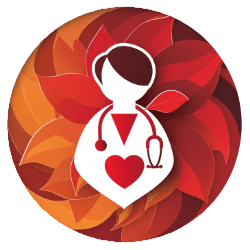After a 12-hour shift, your feet are throbbing, your back aches, and the tension in your neck feels like it's here to stay. You're not alone in this struggle; many nurses face the same physical demands and stressors daily. It's crucial to find effective ways to alleviate this tension and care for your well-being.
Yoga offers a practical solution, with poses specifically tailored to address the areas most affected by your demanding profession. From the soothing stretch of the Child's Pose to the strengthening stance of the Warrior II, each pose has the potential to transform your after-work routine, promoting relaxation and recovery.
Let's explore these poses further, uncovering how they can not only ease your physical discomfort but also provide a mental respite from the challenges of nursing.
Key Takeaways
- Poses like Mountain Pose and Warrior II improve posture and strengthen leg muscles.
- Cat-Cow Stretch and Child's Pose relieve back tension and promote relaxation.
- Downward-Facing Dog and Legs-Up-The-Wall Pose enhance overall well-being and reduce fatigue.
- Triangle Pose and Seated Forward Bend enhance flexibility and provide mental relaxation.
Mountain Pose (Tadasana)
As a nurse, embracing Mountain Pose (Tadasana) can significantly improve your posture and awareness, serving as a solid foundation for stress relief in your demanding routine. Standing straight, with your feet hip-width apart, you allow your body to align itself from the ground up. By pressing your feet firmly into the floor, you activate the muscles in your legs, creating a sense of groundedness and stability.
Mountain Pose doesn't just help you stand tall; it also encourages you to pull your shoulders back and engage your core, which is crucial for improving posture. As someone who spends long hours on your feet, caring for others, you'll find that this pose helps counteract the slouching and bending that come with the job. It strengthens your thighs, knees, and ankles while firming the abdomen and buttocks, enhancing your physical resilience.
Moreover, Tadasana increases strength and mobility in your feet, legs, and hips, and creates space in your chest and lungs. This not only promotes relaxation but also reduces fatigue, making it easier for you to breathe deeply and stay alert.
Integrating Mountain Pose into your daily routine is a simple yet powerful way to care for your well-being, so you can continue serving others with compassion and dedication.
Cat-Cow Stretch
You know how the demands of nursing can weigh heavily on your body, especially your back and neck.
By learning to perform the Cat-Cow Stretch correctly, you're taking a step towards soothing that tension and enhancing your spinal flexibility.
It's a simple yet effective way to care for yourself amidst the hustle of your daily routine.
Benefits for Nurses
For nurses dealing with back pain and stiffness, the Cat-Cow stretch offers a simple yet effective way to enhance spinal flexibility and alleviate tension. As healthcare workers, you're constantly on your feet, bending and lifting, which can lead to physical pain and stress.
Incorporating this stretch into your routine can:
- Relieve tension in your back, letting you focus on caring for others without being hindered by discomfort.
- Help you feel more energized and ready to tackle the demands of your shifts.
- Reduce the risk of chronic pain, ensuring you can continue serving those in need.
- Promote relaxation and relieve stress, keeping you emotionally and physically balanced.
Performing Correctly
Regularly incorporating the Cat-Cow stretch into your daily routine can significantly alleviate back and torso tension, ensuring you're in optimal condition to care for others. Practice this stretch by starting on all fours.
| Step | Direction | Breath |
|---|---|---|
| 1 | Arch your back upwards | Inhale |
| 2 | Transition to dropping your belly, lift your head | Exhale |
| 3 | Feel the stretch in your spine | Maintain breathing |
| 4 | Make sure to move smoothly between positions | Maintain rhythm |
Performing correctly allows you to feel the stretch where it's needed most. Please consult a healthcare professional if you're unsure about your form. Remember, taking the time to perform the Cat-Cow stretch can greatly contribute to your well-being, enabling you to provide the best care.
Child's Pose (Balasana)
After a long shift on your feet, slipping into Child's Pose can offer the much-needed release, stretching your hips, thighs, and ankles to melt away the tension. As a nurse, you dedicate your days to caring for others, often neglecting your own well-being. Child's Pose is a gentle reminder to prioritize yourself, too. It's a simple yet profound way to relieve pain and bring attention back to your body.
- Embrace the Benefits:
- Child's Pose elongates your lower back, offering relief that feels like a warm embrace after hours of standing or walking.
- It reduces stress and fatigue, enveloping you in a sense of calm and making it easier to face your next shift with a refreshed spirit.
- The pose encourages relaxation of the muscles on the front of your body, especially tension in the neck and the tops of your thighs, areas that bear the brunt of your physically demanding job.
To enter Child's Pose, simply kneel, sit back on your heels, lean forward, and extend your arms in front of you. Let your forehead touch the ground and breathe deeply. This moment of tranquility is your sanctuary, a place to rejuvenate and prepare yourself to continue serving others with compassion and care.
Downward-Facing Dog (Adho Mukha Svanasana)
Diving into Downward-Facing Dog (Adho Mukha Svanasana) can be a game-changer for nurses, offering a powerful stretch that builds strength and alleviates tension from head to toe. As you're constantly on your feet, caring for others, it's crucial to take a moment to care for yourself too. Downward dog is more than just a stretch; it's a moment of reprieve for your tired body.
| Benefit | How It Helps |
|---|---|
| Builds bone density in the arms | Supports physical resilience |
| Builds upper body strength | Enhances capacity for patient care |
| Decreases fatigue | Improves energy levels |
| Decreases back pain and stiffness | Enables longer periods of patient care without discomfort |
| Boosts circulation | Enhances overall well-being |
This pose specifically targets the areas most affected during your long shifts—your feet, hips, neck, and shoulders. By elevating your heart above your head, it not only boosts circulation but also provides a sense of rejuvenation. Remember, taking the time to stretch in the downward dog can significantly improve your ability to serve others, making it an essential part of your self-care routine.
Warrior II (Virabhadrasana II)
Stepping into Warrior II (Virabhadrasana II) can offer nurses a powerful stance that not only strengthens the legs but also opens up the hips, providing essential relief after long hours on your feet. This pose channels your inner strength, mirroring the resilience you show every day in caring for others.
Position your right foot forward, ensuring your right knee is bent directly over the ankle. Your left foot should be firmly planted, toes pointing slightly inward. Sink deeper into the pose, feeling your left hip open as you stretch.
- By extending your arms straight, one reaching forward and the other back, you create a line of energy that spans through your entire body.
- This posture demands balance and concentration, qualities you already possess in your demanding role.
- As you gaze over your right hand, envision the positive impact you make, the lives you touch, and the strength you embody.
Lean forward at the hips, engaging your core, and feel the release in your shoulders and neck, areas that often bear the brunt of your hard work.
Warrior II isn't just a pose; it's a reminder of your power, resilience, and dedication to serving others.
Triangle Pose (Trikonasana)
Transitioning into Triangle Pose (Trikonasana) offers a comprehensive stretch that targets your legs, improves flexibility, and relieves tension, making it a perfect addition to your de-stressing routine. As a nurse, you're constantly on your feet, serving others with dedication. Incorporating this yoga pose into your daily routine can not only alleviate physical stress but also refresh your mind, allowing you to continue providing the best care with renewed energy.
| Benefit | Target Area | Impact |
|---|---|---|
| Strengthens | Thighs, knees, ankles | Reduces risk of injuries |
| Stretches | Hips, groins, hamstrings, calves | Improves flexibility |
| Enhances | Posture, digestion | Relieves back pain, sciatica |
To perform Triangle Pose, stand with your feet wide apart. Turn your right foot out 90 degrees and your left foot in slightly. Extend your arms to the sides, parallel to the ground. Reach out with your right hand as you tilt your hips to the left, then lower your right hand to your ankle, shin, or the ground while extending your left hand upwards. Look up towards your left hand, feeling the stretch and opening in your chest, shoulders, and spine. Hold, breathe, and then switch sides. Triangle Pose (Trikonasana) isn't just a physical stretch; it's a moment of balance and reflection, vital for everyone, especially those who dedicate their lives to caring for others.
Bridge Pose (Setu Bandhasana)
Exploring Bridge Pose (Setu Bandhasana) can offer you a comforting stretch and strength-building exercise, essential after a long day of caring for others. This pose not only helps relieve stress and fatigue by stretching your chest, neck, and spine but also strengthens your back, buttocks, and hamstrings. This is particularly beneficial for improving your posture and reducing back pain, a common issue after hours of standing or bending.
Bridge Pose (Setu Bandhasana) is versatile and can be modified to suit your needs, making it a perfect choice for any nurse looking to alleviate tension and improve overall well-being. Here's how it touches your life:
- Emotional Relief
- *Helps reduce* fatigue, promoting relaxation.
- Stimulates abdominal organs, improving digestion and alleviating discomfort.
- Physical Well-being
- Strengthens lower back, supporting better posture.
- Stretches hips back, reducing stiffness.
- Spiritual Connection
- As you *raise your arms*, feel the release of the day's burdens.
- Encourages a moment of mindfulness, reconnecting with your body.
Incorporating Bridge Pose into your routine can be a powerful tool in managing the physical and emotional demands of nursing, allowing you to continue serving others with compassion and care.
Seated Forward Bend (Paschimottanasana)
After focusing on strengthening and stretching with Bridge Pose, let's now turn our attention to Seated Forward Bend (Paschimottanasana), another effective way to ease tension and promote well-being after your demanding shifts. This pose stretches your spine and hamstrings, directly addressing the discomfort many nurses feel in their lower back and shoulders after hours of work. By leaning into Seated Forward Bend, you're not just relieving physical strain; you're also creating space for mental relaxation, which is crucial for staying sharp and compassionate on the job.
Imagine the relief as you gently fold toward the floor, allowing stress and fatigue to melt away. Paschimottanasana calms your mind, helping you find peace amidst the chaos of healthcare. It's a moment of quiet that can lead to better sleep and clearer thinking. Plus, this pose encourages you to maintain good posture, a gift to your body after long periods of standing or bending.
What's more, Seated Forward Bend is adaptable. Regardless of your flexibility level, you can modify it to suit your needs, making it a staple in your self-care toolkit. It's a simple, yet profoundly beneficial way to care for yourself, so you can continue to care for others.
Legs-Up-The-Wall Pose (Viparita Karani)
Shifting gears to another restorative gem, let's delve into the Legs-Up-The-Wall Pose (Viparita Karani), a simple yet powerful way to counteract the physical demands of nursing. After being on your feet all day, embracing this pose not only offers a moment of tranquility but also a bundle of health benefits tailored just for you.
- Why Practice Yoga, Specifically Viparita Karani?
- Physical Relief: It helps prevent swelling in your legs and feet and alleviates lower back tension, common discomforts after long shifts.
- Mental Clarity: Spending 5-15 minutes in this pose, focusing on deep breathing, can significantly reduce stress levels, promoting a sense of calm and readiness for your next shift.
- Accessibility: This pose doesn't require any special equipment or extensive space. A quiet corner and a wall are all you need to create your mini-retreat.
Yoga Poses for Nurses, like the Legs-Up-The-Wall Pose, are more than just exercises; they're a form of self-care, allowing you to serve others from a place of strength and serenity. So, give yourself these moments of peace; you've earned them.
Corpse Pose (Savasana)
After a long shift, you deserve a moment of complete relaxation, and the Corpse Pose (Savasana) offers just that. We'll guide you through its proper execution to ensure you're reaping all the benefits, from stress reduction to improved sleep.
It's also crucial to be aware of common mistakes to avoid, ensuring your relaxation time is as effective and rejuvenating as possible.
Benefits for Nurses
Why not consider the Corpse Pose (Savasana) as an effortless way for nurses to unwind and rejuvenate after enduring the demands of their shifts? This pose isn't just a moment of stillness; it's a profound tool for healing, both physically and mentally.
- Effective Yoga Poses like Savasana offer:
- Deep relaxation that eases back tension and stress, allowing you to serve with renewed energy.
- Mental clarity that sharpens your focus, ensuring you're always at your best.
- Improved sleep quality, vital for recovering from those long, demanding shifts.
- Incorporating Savasana can lead to:
- A deeper stretch, facilitating a greater range of movement and preventing injuries.
- Energizing Yoga Poses that prep you for the day, turning exhaustion into vitality.
Embrace Savasana for a balanced, mindful approach to your demanding role.
Proper Execution Tips
How can you ensure the Corpse Pose (Savasana) is performed correctly to fully benefit from its restorative effects? Focus on the essentials: relaxation, alignment, and breath. Here's a simple guide:
| Poses | Execution | Tips |
|---|---|---|
| Corpse Pose | Lay flat, let your body sink, arms and legs relaxed | Use props for extra comfort |
| Forward Fold | Bend your knees slightly, fold forward, place your hands on the ground | Keep the spine long |
| On hands and knees | Align your wrists under shoulders, knees under hips | Breathe deeply, relax your neck |
Common Mistakes Avoided
To fully embrace the restorative power of Corpse Pose (Savasana), it's crucial to avoid common pitfalls that hinder relaxation and release. Your dedication to serving others is profound; let that extend to taking care of yourself through your yoga practice.
By steering clear of these mistakes, you'll not only help yourself but strengthen your capacity to help others:
- Not fully releasing the body
- Holding onto stress, which can cloud your mind and weigh down your spirit
- Failing to focus on the breath
- Letting the mind wander, which distances you from the present and the peace it offers
- Skipping Corpse Pose altogether
- Missing out on the rejuvenation needed to serve with vitality and compassion
Frequently Asked Questions
Which Asana Calms Nervous System Reduces Stress?
You're asking about asanas that calm the nervous system and reduce stress. Child's Pose, Legs-Up-The-Wall, Corpse, Forward Fold, and Supine Spinal Twist all help. They're perfect for unwinding after a long day serving others.
Which Yoga Pose Can Be Performed to Reduce Stress and Aid in Sleep Quality?
To melt away the day's stress and lull yourself into a peaceful slumber, you can't beat the Legs-Up-The-Wall Pose. It's a simple yet powerful technique to calm your mind and improve your sleep quality.
What All Yoga Poses Help Us to Relax?
To help you relax, consider trying Downward Facing Dog, Child's Pose, and Supine Thunderbolt Pose. Seated Twist and Ear-to-Shoulder Neck Roll can also soothe tension, enhancing your well-being and aiding in stress relief.
How Can Yoga Help Nurses?
Yoga can significantly ease your burdens, offering physical and mental relief from the stresses of nursing. It improves posture, alleviates pain, and boosts well-being, helping you serve others with renewed energy and compassion.





